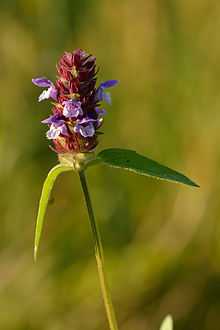Prunella (plant)
| Prunella | |
|---|---|
 | |
| Prunella vulgaris (Common Self-heal) | |
| Scientific classification | |
| Kingdom: | Plantae |
| (unranked): | Angiosperms |
| (unranked): | Eudicots |
| (unranked): | Asterids |
| Order: | Lamiales |
| Family: | Lamiaceae |
| Genus: | Prunella L. |
| Synonyms[1] | |
| |
Prunella is a genus of herbaceous plants in the family Lamiaceae, also known as self-heals, heal-all, or allheal for their use in herbal medicine.
Habitat
Most are native to Europe, Asia, and North Africa, but Prunella vulgaris (the Common Self-heal) is Holarctic in distribution, occurring in North America as well, and is a common lawn weed. Self-heals are low-growing plants, and thrive in moist wasteland and grass, spreading rapidly to cover the ground. They are members of the mint family and have the square stem common to mints.[1][2][3]
Biological descriptions
The common name "self-heal" derives from the use of some species to treat a range of minor disorders. Self-heal can be grown from seed, or divide clumps in spring or autumn.
- Species[1]
- Prunella albanica Pénzes - Albania
- Prunella × bicolor Beck - parts of Europe (P. grandiflora × P. laciniata)
- Prunella × codinae Sennen - Spain (P. hyssopifolia × P. laciniata)
- Prunella cretensis Gand. - Crete
- Prunella × gentianifolia Pau - Spain (P. hyssopifolia × P. vulgaris)
- Prunella grandiflora (L.) Scholler - central + southern Europe from Caucasus to Russia; Caucasus
- Prunella hyssopifolia L. - Spain, France, Italy, Morocco
- Prunella × intermedia Link - central + southwestern Europe (P. laciniata × P. vulgaris)
- Prunella laciniata (L.) L - central + southern Europe, North Africa, Middle East
- Prunella orientalis Bornm. - Turkey, Syria
- Prunella prunelliformis (Maxim.) Makino - Japan
- Prunella × surrecta Dumort. - central + southwestern Europe (P. grandiflora × P. vulgaris)
- Prunella vulgaris L. - widespread in Europe, North Africa, Asia, North America; naturalized in New Zealand parts of South America
Uses
Traditional medicine
| Dried Prunella | |||||||||||||||
| Traditional Chinese | 夏枯草 | ||||||||||||||
|---|---|---|---|---|---|---|---|---|---|---|---|---|---|---|---|
| Simplified Chinese | 夏枯草 | ||||||||||||||
| |||||||||||||||
In the Pacific Northwest, its juice was used by the Quinault and the Quileute on boils. They also used the whole plant to treat cuts and inflammations. Ointments can be made by fixing the plant with grease. Dried Prunella (Chinese: 夏枯草) is used to make a herbal drink.
Food uses
The mildly bitter leaves are also good as salad greens. Prunella species are used as food plants by the larvae of some Lepidoptera species including Coleophora albitarsella.
As a health supplement
Prunella vulgaris is also used as an ingredient in some bodybuilding supplements as for its antiestrogenic activity - for which an efficacy has been demonstrated only in mice.[4]
Scientific study
While most of the traditional uses are clinically untested and of unknown efficacy, Prunella vulgaris has been shown to have pharmacological effects in vitro and in some animal models as an antioxidant, immune stimulant, viral replication inhibitor and an anti-inflammatory agent.[5][6][7][8][9][10] P. vulgaris and P. asiatica have shown some anti-(lung)cancer activity in vitro.[11]
References
- ↑ 1.0 1.1 1.2 Kew World Checklist of Selected Plant Families
- ↑ Flora of China Vol. 17 Page 134 夏枯草 xia ku cao Prunella vulgaris Linnaeus, Sp. Pl. 2: 600. 1753.
- ↑ Altervista Flora Italiana, genere Prunella includes photos plus range maps for Europe + North America
- ↑ Collins, NH; Lessey, EC; Dusell, CD; McDonnell, DP; Fowler, L; Palomino, WA; Illera, MJ; Yu, X et al. (2009). "Characterization of antiestrogenic activity of the Chinese herb, prunella vulgaris, using in vitro and in vivo (Mouse Xenograft) models". Biology of Reproduction 80 (2): 375–83. doi:10.1095/biolreprod.107.065375. PMC 2746405. PMID 18923163.
- ↑ Immune modulatory effects of Prunella vulgaris L. Int J Mol Med. 2005 Mar;15(3):491-6.
- ↑ A polysaccharide fraction from medicinal herb Prunella vulgaris downregulates the expression of herpes simplex virus antigen in Vero cells. J Ethnopharmacol. 2004 Jul;93(1):63-8.
- ↑ Phenolics-rich extracts from Silybum marianum and Prunella vulgaris reduce a high-sucrose diet induced oxidative stress in hereditary hypertriglyceridemic rats. Pharmacol Res. 2004 Aug;50(2):123-30.
- ↑ Biological activities of Prunella vulgaris extract. Phytother Res. 2003 Nov;17(9):1082-7.
- ↑ Anti-allergic and anti-inflammatory triterpenes from the herb of Prunella vulgaris. Planta Med. 2000 May;66(4):358-60.
- ↑ Inhibition of immediate-type allergic reactions by Prunella vulgaris in a murine model. Immunopharmacol Immunotoxicol. 2001 Aug;23(3):423-35.
- ↑ Feng L, Jia XB, Jiang J, Zhu MM, Chen Y, Tan XB, Shi F"Combination of active components enhances the efficacy of Prunella in prevention and treatment of lung cancer." Molecules. 2010 Nov;15(11):7893-906